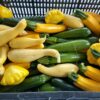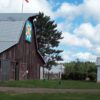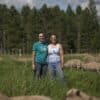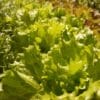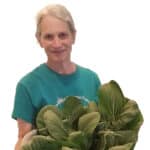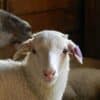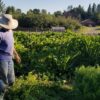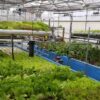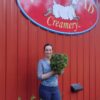Making it Visible

Winter is our time to look back at the previous busy season and celebrate what went well, troubleshoot what we could do better, and dream about new things to add or offer to bring depth and meaning to the Farmstead Creamery experience.
Last year, we tackled projects like processing ALL of our sheep fleeces into yarns for resale—which was a tremendous amount of work coordinating with regional woolen mills, managing shipments, designing labels, etc. The tradeoff has been many happy customers picking out lusciously hand-dyed wool yarns for their knitting and crochet projects. What beautiful gifts and wearables our sheep fleeces have become over the past year!
We also grew our Locally Grown Summer Music Series from just a dozen weekends to every Saturday from Memorial Weekend to the end of September. This mean more bookings, investment in more sound gear, building the performance pergola, and beefing up the advertising strategies. I became dubbed “the great cat herder” for my efforts in organizing all the musicians in time to release publications before summer struck.
This year, one of the trends we had noticed is that many people who come to visit Farmstead only see the shop and don’t know about the rest of the farm. Some don’t even notice the large aquaponics greenhouse right next door! A few have taken the farm tour, which helps broaden the sense of what we do here, and I make a concerted effort to share with people the stories of our farm.
But I can talk until I am blue in the face, and it’s not the same as seeing what happens here. We had been playing with the idea of having a digital picture frame that would rotate images from the farm and be easily updated, but we didn’t have the technology until Steve joined the team. So this last month, we installed a flat screen in the first floor dining room (which you can also see from the front counter area…in case you have to wait a couple of minutes to order your pizza) that offers rich depth in color and a large enough viewing area to see from across the room. The electronic brains powering the screen are neatly tucked in the utility room, so the presentation is clean and uncluttered.
From my laptop in the mini office I have under the staircase, I can upload new images to the slideshow at any time. We can also connect it to the signal from the barn camera when it’s lambing time or use it to show videos we may make in the future—like a walk around inside the greenhouse or a visit with the pigs.
The idea behind the project is to make visible the invisible on the farm—what goes into raising the artisan meats in the display freezer or that golden omelet on your plate. The slideshow has only been running for two days, and already it’s spurring all kinds of neat questions about what we do on the farm and how on earth do we get it all done, alongside running the Creamery & Café.
In the summertime on Saturdays, the Creamery opens for brunch at 8:00 am (by then we’ve put a couple of hours into farm chores and still sometimes need to tag out throughout the morning to get them all finished), with Pizza Farm going until 8:00 pm. Guests have enjoyed their day, they pile into their cars, and think the night is over. But there’s at least another hour’s work packing up the musicians, cleaning up the kitchen and dining areas, and putting the place in order before heading back to the farm for another two or three more hours of chores—hauling feed and water, bringing animals in from pasture, milking the sheep, locking up the coops and collecting eggs, tending to the specific needs of the young animals, etc.
So much happens behind the scenes that guests don’t see. For instance, when a sudden storm comes, there’s not only a rush to bring in bistro umbrellas and glass art in the butterfly gardens, but also half or more of the crew runs back to the farm to bring in the sheep, close down barn doors and windows, drop the sides on chicken tractors (and stake them down if necessary, push wheel barrels, buckets, and tools into garages, and back machinery into the sheds, leaving only a skeleton crew of one or two at the Creamery to “hold down the fort” for customers as potential disaster is being mitigated. I don’t know how many times I’ve found myself in the middle of a rain storm in my front counter clothes, soaked to the bone, trying to save teenaged turkeys from drowning. There simply wasn’t even time to change into farm duds for the task!
In the fall, when the day lengths are shortening, there’s sensitive crops to cover against frost in the evening, pulling off the heavy, dew-soaked covers in the morning. The sun gets bright and someone has to run back to open the south side of the high tunnel or the tomato plants will bake. The sun starts to go down and someone has to run back to close it again before there is too much heat loss and the tomato plants will be cold shocked and not ripen their load of green fruits. All through the growing and baby animal season, the golf cart and bicycles are kept busy back and forth as we work the farm and the Creamery simultaneously. I’ve strapped a basket to my bicycle because invariably there’s something needing to be carried from one side of the campus to the other as well!
Next time you come to visit Farmstead, maybe there will be something new for you to see on the slideshow as well—a peek at beehives, a view from inside the greenhouse, a glimpse at the raised-bed gardens and high tunnel, or an image of the sheep in the pasture. We hope that these selected images will help our guests come to learn more about where their food comes from and the stories of the family that dedicates their lives to making that locally available. Each image is full of stories! I’m sure I’ll be adding more all through the season. See you down on the farm sometime.
